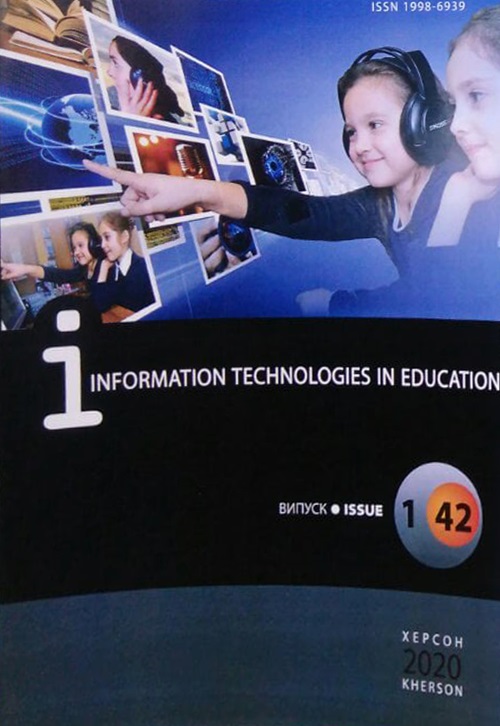INVESTIGATIVE APPROACH IN IN TEACHING THE FUNDAMENTALS OF ARTIFICIAL INTELLIGENCE USING THE MAXIMA SYSTEM
DOI:
https://doi.org/10.14308/ite000714Keywords:
higher educational institution, artificial intelligence, MAXIMA, intellectual tasksAbstract
The article highlights the problem of the use of computer algebra systems (CAS) as a means of educational and research activities in the field of information and mathematical disciplines. The dynamism of the development of modern information technologies requires the integration of related disciplines on a common basis for them on a fundamental basis. The new type of intelligent systems should create the toolkit that will provide the educated person with the means of deeper mastery of the latest advances in computer science and science. The training of the fundamentals of artificial intelligence in the system of training computer science specialists at the pedagogical university plays a special role, since it combines both the fundamental concepts and principles of various mathematical and informational disciplines, and applied models and algorithms for their application. All this should lead to the search and introduction of new educational forms and technologies in education. One of such forms of organization of training is the research and design and research activity of students. Education at a pedagogical university should be a model of research work in the field of specialist work. The role of CAS in the preparation of bachelors in computer science and features of their pedagogical application in teaching the fundamentals of artificial intelligence are defined. The main characteristics of CAS MAXIMA are considered and the possibilities of using this system in the process of solving intellectual problems are given. The expediency of using the Maxima system for a research approach in the process of learning the fundamentals of artificial intelligence in a pedagogical educational institution, as well as determining the perspective ways of its introduction, is substantiated. The purpose of using CAS in the process of preparing future IT specialists is to build on them the ability to successfully use information technology in their professional activities, creative approach to solving non-standard tasks, deep mastering of fundamental fundamentals of disciplines.
The prospect of further research is the expansion of a range of research tasks that can be solved with the use of computer mathematics systems.
Downloads
Metrics
References
2. Бугаєць Н.О. Розвиток навчально-дослідницьких умінь студентів фізико-математичних спеціальностей у процесі навчання математичної інформатики : дис. ... канд. пед. наук : 13.00.02 / Наталія Олександрівна Бугаєць. – К.: НПУ імені М. П. Драгоманова. – 283 с.
3. Глибовець М.М. Штучний інтелект / Глибовець М.М., Олецький О.В. / : Підруч. для студ. вищ. навч. закладів. – К : Вид. дім «КМ Академія», 2002. – 336с.
4. Гриб’юк О.Дослідницький підхід у навчанні з використанням системи динамічної математики GeoGebra / О. Гриб’юк, В. Юнчик // Актуальні питання гуманітарних наук. - 2016. - Вип. 15. - С. 284-298.
5. Кирсанов М.Н. Графы в Maple. Задачи, алгоритмы, программы. – М.: Издательство ФИЗМАТЛИТ, 2007. – 168 с.
6. Клочко В. І. Нові інформаційні технології навчання математики в технічній вищій школі: дис. … доктора пед. наук / Віталій Іванович Клочко. — К. : НПУ імені М. П. Драгоманова, 1997. — 396 с.
7. Кобильник Т. П. Системи комп’ютерної математики: Maple, Mathematica, Maxima / Т. П. Кобильник. – Дрогобич : Редакційно-видавничий відділ ДДПУ імені Івана Франка, 2008. – 316 с.
8. Леонтович А. В. Модель научной школы и практика организации исследовательской деятельности учащихся / А.В. Леонтович // Школ. технологии. – 2001. – №5. – C. 146-149.
9. Осипова Н. Модель формування дослідницької компетентності у майбутніх інженерів-програмістів / Н.Осипова, М.Вінник, Ю.Тарасіч // Інформаційні технології в освіті. – 2014. – № 20. – С. 150-159.
10. Ракута В. М. Система динамічної математики GeoGebra як інноваційний засіб для вивчення математики [Електронний Ресурс] / В. М. Ракута. // Інформаційні технології і засоби навчання. – 2012. – №4 (30). – Режим доступу до журналу: http://www.journal.iitta.gov.ua.
11. Спірін О. М. Диференційований підхід у вивченні основ штучного інтелекту в курсі інформатики фізико-математичного факультету вищого педагогічного закладу:: дис. ... канд. пед. наук : спец. 13.00.02 / Олег Михайлович Спірін. – Житомир, 2001. – 197с.
12. Триус Ю. В. Використання WEB-СКМ у навчанні методів оптимізації та дослідження операцій студентів математичних та комп’ютерних спеціальностей / Ю. В.Триус // Інноваційні комп’ютерні технології у вищій школі : матеріали 4-ої наук.-прокт. конференції / Національний університет "Львівська політехніка", – Львів : В-во Львівська політехніка, 2012, – С. 110-115
13. Шишкіна М. П. Методичні рекомендації з використання хмаро орієнтованого компонента на базі системи Maxima у навчанні інформатичних дисциплін / М. П. Шишкіна, У. П. Когут. – Дрогобич : Ред.-вид. відділ ДДПУ ім. І. Франка, 2014. – 57 с
Downloads
Published
How to Cite
Issue
Section
License
This work is licensed under a Creative Commons Attribution-NonCommercial-ShareAlike 4.0 International License.






























